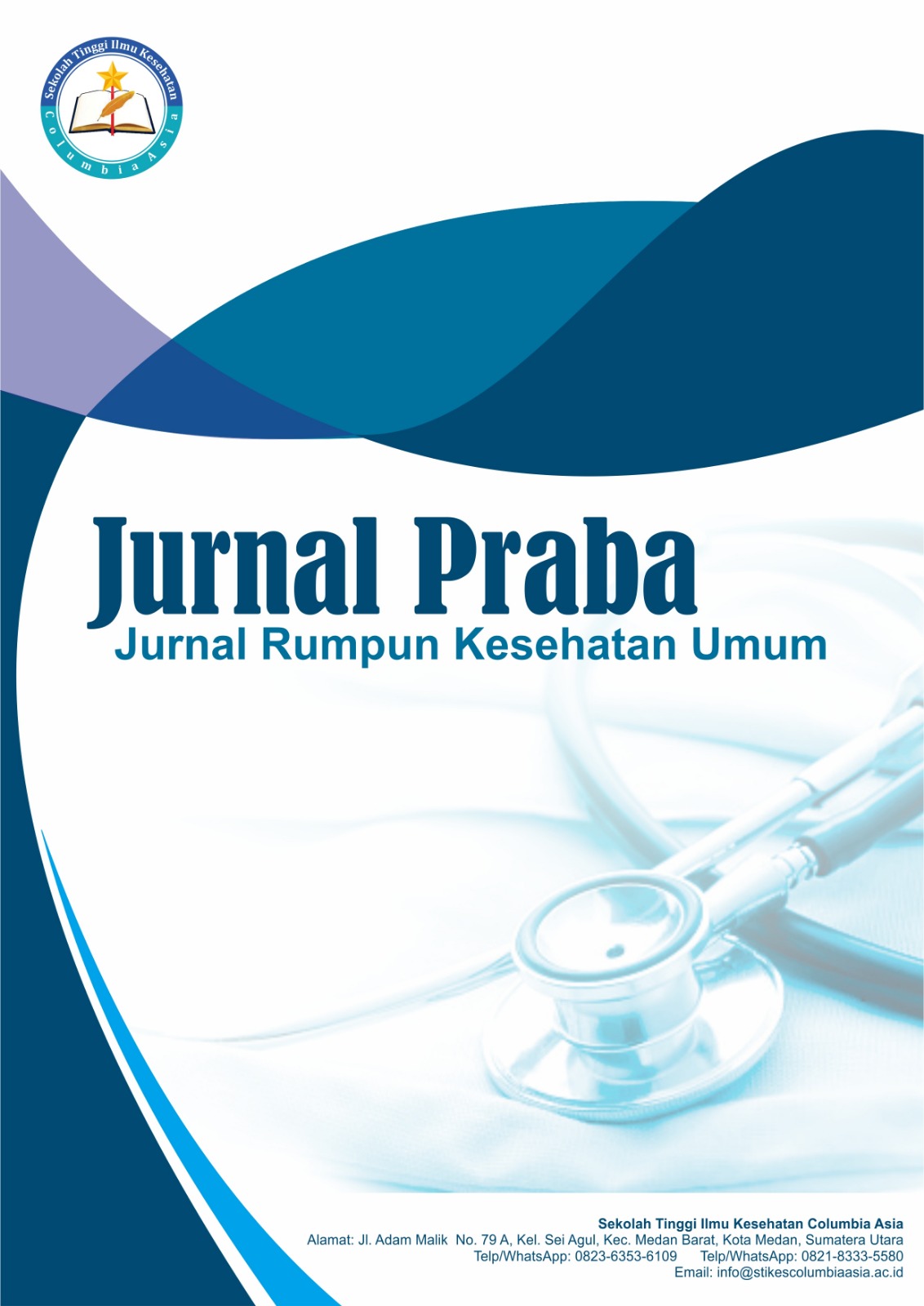Literature Review : Kandungan Fitokimia dan Potensi Daun Teh Hijau (Camellia sinensis) dalam Menurunkan Risiko Obesitas
DOI:
https://doi.org/10.62027/praba.v3i1.339Keywords:
Camellia sinensis, Green Tea, Obesity, PhytochemicalsAbstract
Green tea (Camellia sinensis) belongs to the genus Camellia from the Theaceae family. This plant has been used as traditional medicine for generations and is known to have various pharmacological activities. The purpose of this review is to discuss the benefits of green tea in reducing the risk of obesity by reviewing its botanical characteristics, phytochemical content, use and bioactivity to treat obesity obtained and compiled from literature searches through search engines such as Google Scholar, Science Direct, and PubMed. then discussed narratively. The results obtained indicate that green tea extracts and drinks can reportedly help increase the body's metabolism, which contributes to the reduction of body fat. Many studies report that this plant contains phytochemical compounds such as flavonoids, alkaloids, steroids, triterpenoids and carbohydrates. Epigallocationchin-3-gallate, L-theanine, and caffeine, which are respectively classified as flavonoids, amino acids, and alkaloids, are considered responsible for their pharmacological activity in treating obesity. EGCG has a hypocholesterolemic effect and suppresses cholesterol absorption in the intestine, L-theanine itself has physiological effects such as relaxation activities, and caffeine is useful in reducing food intake and has a thermogenic effect which can encourage weight loss.
References
Alghamdi, A. I. (2023). Antibacterial activity of green tea leaves extracts against specific bacterial strains. Journal of King Saud University, 35(5), 1–7.
Aulyawati, N., Yahdi, Y., & Suryani, N. (2021). Skrining fitokimia dan aktivitas antioksidan ekstrak etanol rambut jagung manis (Zea mays ssaccharata strurf) menggunakan metode DPPH. Spin Jurnal Kimia & Pendidikan Kimia, 3(2), 132–142.
Bimanto, H., Wahyuni, Y. D., Mutiarawati, D. T., & Endarini, L. H. (2020). Phytochemical screening and in vitro antibacterial activity of green tea (Camellia sinensis L.) extract against Staphylococcus epidermidis. Health Notions, 4(8), 261–266.
Franata, A., Syahrian, M. F., Eldin, E., & Puspawani, Y. (2023). Effect of green tea extract (Camelia sinensis) on weight reduction in obesity male Wistar rats (Rattus norvegicus). Jurnal Eduhealt, 14(4), 166–174.
Geoffrey, K. K., John, K. M., Naomi, M., & Simon, K. M. (2020). Qualitative phytochemical screening of Camellia sinensis and Psidium guajava leaf extracts from Kericho and Baringo counties. IJBR, International Journal of Advanced Biotechnology and Research, 5(3), 505–512.
Kalauni, S. K., Karki, J., Sharma, M., & Khanal, L. N. (2024). Phytochemical screening, evaluation of antioxidant and antidiabetic activities of green tea available in Nepal. Prithvi Academic Journal, 7, 9–19.
Khursid, Z., Zafar, M. S., Zohaib, S., Najeeb, S., & Naseem, M. (2016). Green tea (Camellia sinensis): Chemistry and oral health. The Open Dentistry Journal, 10, 166–173.
Kok, T., Wiriantono, V., Bakhriansyah, J., & Aditama, L. (2023). The factors affecting the occurrence of obesity in college students. Unnes Journal of Public Health, 12(1), 71–78.
Leslie, P. J., & Gunawan, S. (2019). Uji fitokimia dan perbandingan efek antioksidan pada daun teh hijau, teh hitam, dan teh putih (Camellia sinensis) dengan metode DPPH (2,2-difenil-1-pikrilhidrazil). Tarumanagara Medical Journal, 1(2), 383–388.
Lindawati, N. Y., & Anggraini, R. (2020). Pemanfaatan ekstrak etanol teh hijau (Camellia sinensis L.) sebagai chelating agent logam berat Cu dengan metode SSA. Jurnal Farmasi Galenika, 6(2), 295–302.
Narmada, I. B., Sarasati, A., Wicaksono, S., Rezkita, F., Wibawa, K. G. P., Hayaza, S., & Nugraha, A. P. (2020). Phytochemical screening, antioxidant activity, functional groups, and chemical element characterization analysis of (-)-epigallocatechin-3-gallate (EGCG) in East Javanese green tea methanolic extract: An experimental in vitro study. Systematic Reviews in Pharmacy, 11(5), 511–519.
Omran, A. M., Sa’ady, A. T. A., & Saleh, R. H. (2023). Phytochemical screening, antibacterial activity, and chromatographic study of Camellia sinensis. Medical Journal of Babylon, 20(4), 790–796.
Rismayanthi, C., & Purnama, Y. O. (2021). The effect of green tea (Camellia sinensis) with aerobic exercise for weight loss in obese adolescents. MEDIKORA, 20(2), 162–171.
Riswanti, I. (2016). Media buletin dan seni mural dalam upaya meningkatkan pengetahuan tentang obesitas. Journal of Health Education, 1(1), 62–70.
Rubab, S., Rizwani, G. H., Durrani, A. I., Liaqat, I., Zafar, U., Mahjabeen, Batool, F., Seher, N. E., Younas, N., & Sadiqa, A. (2022). Phytochemical and pharmacological potential of Camellia sinensis L. Pakistan Journal of Zoology, 55(2), 669–678.
Sari, N., & Andjasmara, T. C. (2023). Penanaman tanaman obat keluarga (TOGA) untuk mewujudkan masyarakat sehat. Jurnal Bina Desa, 5(1), 124–128.
Ukwubile, C. A., Malgwi, T. S., Dibal, M. Y., Bababe, A. B., & Bingari, M. S. (2020). Phytochemical composition and toxicity evaluation of Camellia sinensis (L.) O. Kuntze (Theaceae) (green tea) leaves collected from Mambila Beverages Ltd Nigeria. IJMPNP, International Journal of Medicinal Plants and Natural Products, 6(2), 7–13.
Zalukhu, A. M. R., & Lubis, D. M. (2020). Pengaruh pemberian ekstrak daun teh hijau (Camellia sinensis) terhadap penurunan berat badan pada tikus putih (Rattus norvegicus L.) jantan galur Wistar yang diberi diet tinggi lemak. Jurnal Pandu Husada, 1(3), 171–177.
Downloads
Published
How to Cite
Issue
Section
License
Copyright (c) 2025 Jurnal Praba : Jurnal Rumpun Kesehatan Umum

This work is licensed under a Creative Commons Attribution-ShareAlike 4.0 International License.







